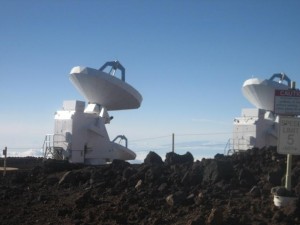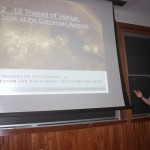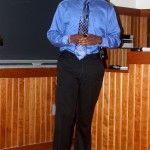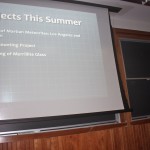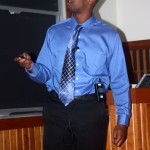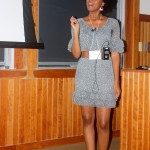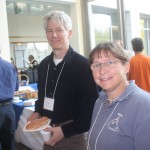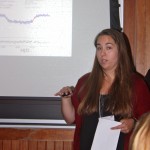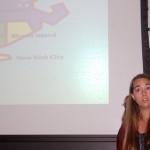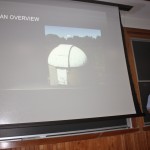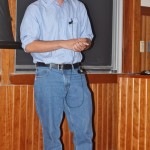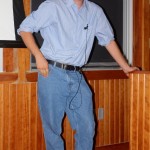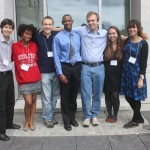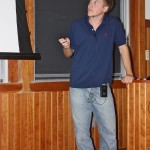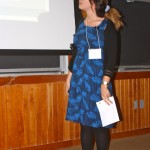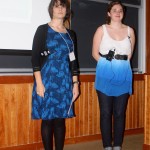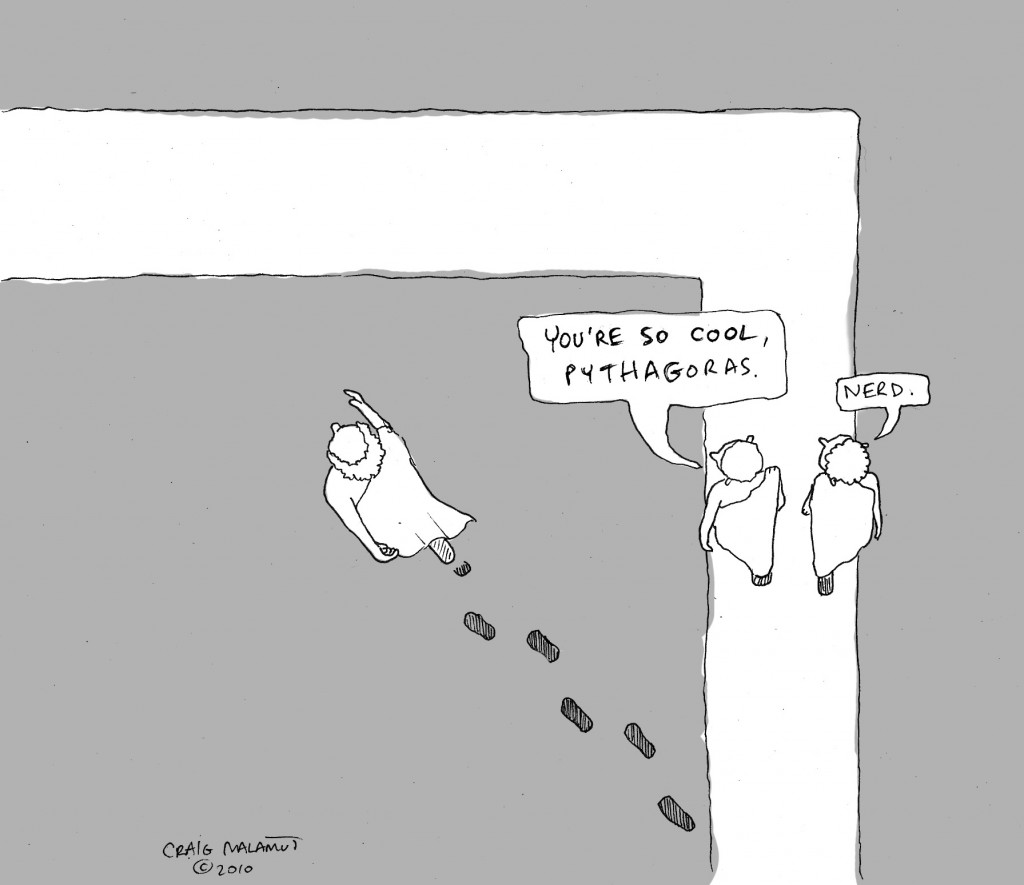We’ll post more pictures of the reinstallation process soon, but for now, here’s a quick comparison of the mirror before re-aluminization and after.
Uncategorized
Re-aluminizing the 24″ Perkin Telescope Mirror
Periodically, telescopes need to have their mirrors cleaned and coated with a new layer of shiny aluminum. Here are some photos of the removal of the 24″ mirror and preparation to ship it off for re-aluminizing on May 9th, 2013.
 The telescope backplane with all instruments removed.
The telescope backplane with all instruments removed.
 Astronomy professor Seth Redfield and Bruce Strickland from the Wes science machine shop move the lift into place for lowering the mirror cell.
Astronomy professor Seth Redfield and Bruce Strickland from the Wes science machine shop move the lift into place for lowering the mirror cell.
 Dave Strickland from the science machine shop aligns the lift. The mirror cell rests on metal cylinders as it is lowered from the telescope.
Dave Strickland from the science machine shop aligns the lift. The mirror cell rests on metal cylinders as it is lowered from the telescope.
 Dave Strickland removes the central tube from the 24″ mirror cell.
Dave Strickland removes the central tube from the 24″ mirror cell.
 The mirror cell rests on blocks as we prepare to remove the mirror itself.
The mirror cell rests on blocks as we prepare to remove the mirror itself.
 The 24″ mirror. As you can see, the surface looks a bit dirty.
The 24″ mirror. As you can see, the surface looks a bit dirty.
First light for radio telescope!

The students in Wesleyan’s upper-level Radio Astronomy course have spent the semester assembling a Small Radio Telescope (SRT), designed by Alan Rogers at Haystack Observatory. Today the newest member of Wes’s telescopic arsenal saw first light! We employed the total power capability to detect the Sun and used it to map out the telescope beam (spectroscopy is still in the works). Students in Wesleyan astronomy classes can use this telescope to study bright radio sources like the Sun, Cyg-X, and Cas A; map galactic rotation (detect your own dark matter!); and practice principles of radio astronomy.
Many, many thanks are due to the experts who advised the students on assembling the different system components, and worked on some of the hairier machining and electronics: Jon Wallace (Wes alumnus, SARA member, and radio telescope builder extraordinaire), Dave and Bruce Strickland (of the Wesleyan machine shop), and Mike Koziol (our electronics wizard). Wesleyan is the first university to assemble the upgraded SRT system based on the parts list and plans published by Haystack, rather than buying the system as a kit as other universities were able to do in the past, so we needed all the help we could get. Sophomore Laiya Ackman also volunteered her free time to help assemble the dish.


You can see photos from the official Wesleyan photo blog here. And here are a few pictures from various stages of the construction process:



Possible Aurora Tonight!
Central Connecticut is right on the edge of accuweather’s predicted optimal viewing zone for an auroral display on earth tonight. The remains of a solar storm will be sweeping by, hopefully right around sunset on the east coast. Keep an eye on the sky tonight!

Read more here!
Up On Top of the Volcano, Down in the Submillimeter Valley
Where engineers build their telescopes, astronomers will inevitably come. One of the great perks of having a career path associated with the night sky is the opportunity to visit places where the stars I study shine the brightest. Thanks to Wesleyan University’s newest Assistant Professor of Astronomy, Meredith Hughes, I (Eric Edelman ’13) was able to assist as a student observer at the Submillimeter Array (SMA) on the big island of Hawaii for spring break. Mahalo, Meredith!
The SMA is a telescope array composed of eight individual antennas that specializes in submillimeter, or radio, wavelengths. It is situated near 13,000 feet above sea level, close to the summit of Mauna Kea, one of Hawaii’s inactive volcanoes. This daunting altitude helps the SMA to avoid many atmospheric issues that particularly stymie ground based submillimeter observations. Fortunately, the observing station has an oxygenated control room, so I was able to remain coherent enough during my stay to absorb and document my nights as half guest observer and half gawking, consistently over-impressed tourist.
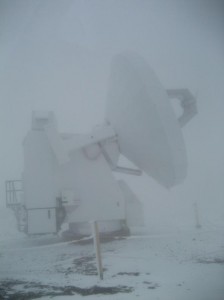 My five days on the summit gave me a quick glimpse into the many and varied challenges face by ground-based observers. In particular, the weather during my trip was extremely changeable. On my first night at that dark, isolated summit, the starry night sky was clear and vivid enough to drown in. That night, the SMA engineers worked on installing new hardware and the observers set the antennas’ sights on an AGN (active galactic nucleus), which is an extremely luminous galactic nucleus, thought to be caused by large-scale, energetic accretion of matter into the galaxy’s supremely supermassive black hole. However, by my fifth and last observing night, wind and icy snow buffeted the summit, shaded by thick, unmoving clouds, and observing or testing anything was as far from possible as it ever could be. A big portion of an observer’s job is to keep one’s eyes trained on those weather sites in order to adapt accordingly to whatever challenges the fickle weather patterns end up throwing his or her way.
My five days on the summit gave me a quick glimpse into the many and varied challenges face by ground-based observers. In particular, the weather during my trip was extremely changeable. On my first night at that dark, isolated summit, the starry night sky was clear and vivid enough to drown in. That night, the SMA engineers worked on installing new hardware and the observers set the antennas’ sights on an AGN (active galactic nucleus), which is an extremely luminous galactic nucleus, thought to be caused by large-scale, energetic accretion of matter into the galaxy’s supremely supermassive black hole. However, by my fifth and last observing night, wind and icy snow buffeted the summit, shaded by thick, unmoving clouds, and observing or testing anything was as far from possible as it ever could be. A big portion of an observer’s job is to keep one’s eyes trained on those weather sites in order to adapt accordingly to whatever challenges the fickle weather patterns end up throwing his or her way.
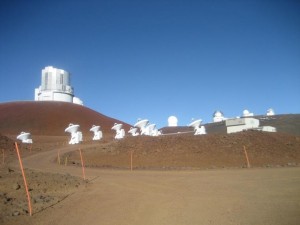 While the sudden snow storm was certainly exciting, I could not enjoy those nights quite as much as I could the clear ones, when actual observing occurred. On those nights, when everything was in working order, every so often I could not help but lean back in my chair in that chilly control room and try and digest the magnitude of this whole operation. Right in front of me, only about ten yards away, was an array of telescopes pointed at and collecting information on an object most likely millions of parsecs away from us. The scale and finesse of observational astronomy has never ceased to impress me, and seeing the SMA in action was a treat to be remembered.
While the sudden snow storm was certainly exciting, I could not enjoy those nights quite as much as I could the clear ones, when actual observing occurred. On those nights, when everything was in working order, every so often I could not help but lean back in my chair in that chilly control room and try and digest the magnitude of this whole operation. Right in front of me, only about ten yards away, was an array of telescopes pointed at and collecting information on an object most likely millions of parsecs away from us. The scale and finesse of observational astronomy has never ceased to impress me, and seeing the SMA in action was a treat to be remembered.
For any readers local to the Wesleyan campus, keep in mind that public observing is held at the campus observatory on clear Wednesday nights from 8:00-9:00pm. We cannot promise you AGNs, but I would still highly recommend a trip to Van Vleck to see the stars if you can make it!
Solar Eclipse of Nov. 13, 2012
Amy Steele, a first year MA student viewed the solar eclipse of Nov. 13, 2012, from northern Australia and sent along the attached photo. She was part of a team hoping to make measurements during totality but it looks like clouds got in the way. Nonetheless, they were able to see parts of the eclipse and she got a very nice image of a partial phase viewed through the clouds.
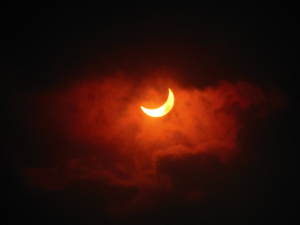
Wesleyan Students Speak at Undergraduate Research Symposium
Seven students represented Wesleyan at the Fall 2012 Undergraduate Research Symposium of the Keck Northeast Astronomy Consortium (KNAC) held at Middlebury College on Sept. 21. All of them presented talks on their summer research projects to an audience of about 80 students and faculty from the KNAC schools. The presenting students were:
Kerry Klemmer, a senior astronomy major
Lily Zucker, a junior astronomy major
Miche Aaron, a junion E&ES major
Ben Tweed, a senior astronomy major
Eric Edelman, a senior astronomy major
Mark Popinchalk, a senior astronomy major
James Dottin, a senior E&ES major
Congratulations to all of them for their fine contributions to this exciting conference! Also among the pictures find Wesleyan Professor Ed Moran speaking with Prof. Kim McLeod of Wellesley College during one of the coffee breaks.
KH 15D on YouTube
The unique behavior of this “winking star” was discovered in 1995 with the 24 inch (Perkin) telescope at Van Vleck. We continue to follow it at Wesleyan but most data now comes from the SMARTS telescope at Cerro Tololo Interamerican Observatory in Chile. It has been fascinating to see the light curve evolve over the years as precession of the disk has caused various parts of the orbits of the stars to be covered or revealed.
Just recently the star has brightened again, unexpectedly, and it appears that the previously unseen binary component is now peeking out the bottom of the disk. This phase is not shown in the current animation because it was created before we knew this was going to happen.
An interesting aspect of the star is that when it forms a planetary system (IF it forms one!) the planets will probably transit the stars, just like several systems recently discovered by the Kepler satellite, including Kepler 16 (sometimes referred to as Tatooine, after the mythical Star Wars planet orbiting a binary star). KH 15D may, therefore, be described as a proto-Tatooine.
Summer Research in Astronomy: Wesleyan Students Get Around!
The summer of 2011 was a banner year for Wesleyan students doing research in astronomy. No fewer than SIX of our students obtained competitive REU (Research Experiences for Undergraduates) assistantships sponsored by the National Science Foundation. Alexandra Truebenbach spent the summer in Puerto Rico at the Arecibo Radio Observatory. Phillip Adams and Nora Dumont were in Sunspot, New Mexico at the National Solar Observatory while Alissa Fersch was in Tucson, Arizona at the National Optical Astronomy Observatory. Ben Tweed spent the summer at Colgate University in New York, while David Amrhein split time between Williams College in Massachusetts and Hawaii, where he observed an occultation of Pluto by its moon, Charon.
All of this follows on the heals of a rare experience last year for senior astronomy major Craig Malamut. He joined an expedition to Easter Island to observe a total solar eclipse of the Sun. For more on Craig’s adventures and studies, please see the article about him in the latest issue of the Wesleyan Connection.
If you are a Wesleyan undergraduate interested in astronomy now is the time to start thinking about research for next summer. A good starting place is the Web site of the Keck Northeast Astronomy Consortium. You will find information about KNAC’s REU program and also links to other REU programs across the nation. Also, if you are passing by the poster outside of the classroom in the Observatory, take a look! There are many opportunities available. Application deadlines are approaching, so it is best to start looking now. What better way to spend your summer?!





